Improvements To Modified SDA SRS 1.2TL Crossover
Comments
-
Those inductors are HUGE:eek:DarqueKnight wrote: »Yeah, and they still fit in!!!

Thats what she said......
 :biggrin::eek:
:biggrin::eek:
Would like to thank you for your continued writeups and modifications. Gives me something to aspire to...."....not everything that can be counted counts, and not everything that counts can be counted." William Bruce Cameron, Informal Sociology: A Casual Introduction to Sociological Thinking (1963) -
DK you just got too much money and spare time on your hands.

You probably missed the thread where I admitted that I am spending my children's inhieritance. BTW: Did you ever get an answer back on the schematics ?
BTW: Did you ever get an answer back on the schematics ?
No. I sent the request to Matthew Polk on 12/12/10. I'll try Stu Lumsden.Proud and loyal citizen of the Digital Domain and Solid State Country! -
DarqueKnight wrote: »You probably missed the thread where I admitted that I am spending my children's inhieritance.

Maybe so but they'll have some really sweet SDA's unless you plan on taking with them to the grave with you. :rolleyes:“The two most important days in your life are the day you are born and the day you find out why.” ~ Mark Twain -
Measurements-So Fresh, So Clean!
The Solen inductors exhibited much better measured noise performance prior to conditioning on the Cable Cooker compared to the Northcreek inductors. Figures 1 and 2 show the output signals of the Northcreek 14 AWG inductors (left) and Solen 10 AWG inductors at the beginning of conditioning on the Audiodharma Cable Cooker.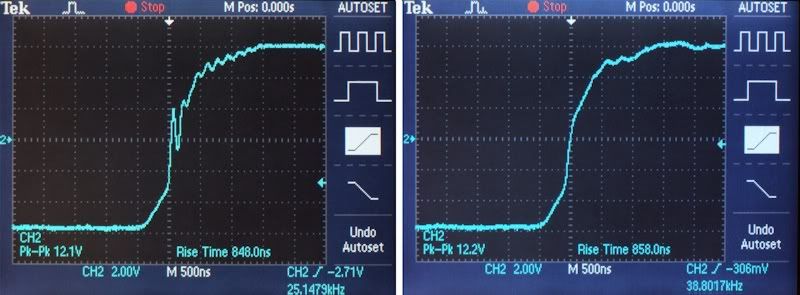
Figure 1. Rising edge of the Cable Cooker's conditioning signal pulse from the Northcreek inductors (left) and Solen inductors
(right) at the beginning of conditioning.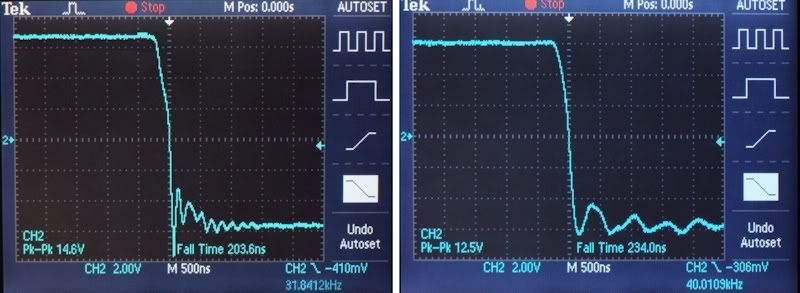
Figure 2. Falling edge of the Cable Cooker's conditioning signal pulse from the Northcreek inductors (left) and Solen inductors
(right) at the beginning of conditioning.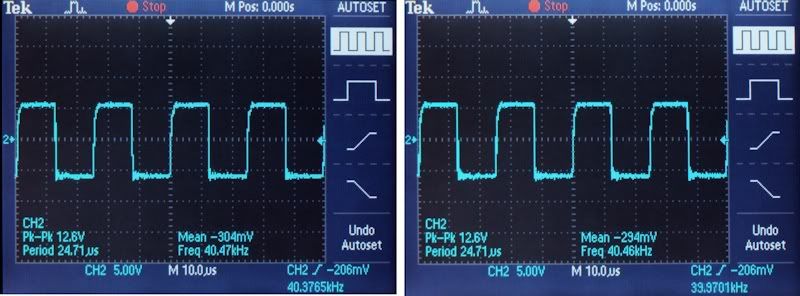
Figure 3. Cable Cooker output pulse train (left) and Inductor output pulse train (right) at 0 hours of conditioning.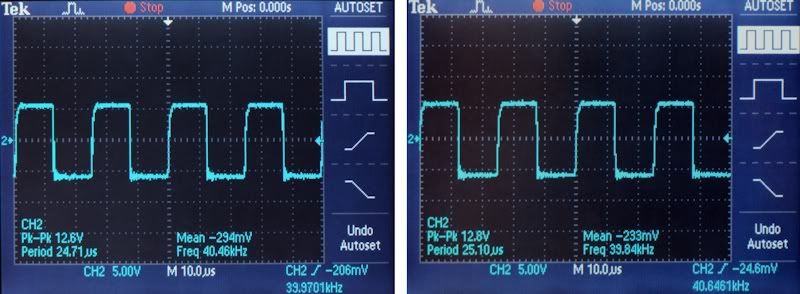
Figure 4. Cable Cooker output pulse train (left) and Inductor output pulse train (right) at 55 hours of conditioning.
Figure 5. Northcreek inductor output pulse train (left) and Solen Inductor output pulse train (right) at 0 hours of conditioning.
The Solen inductor's output signal was very close to the output signal from the Cable Cooker (figures 3, 4, 6 and 7). This contrasts sharply with the initial output signal from the Northcreek inductors (figures 1, 2 and 5).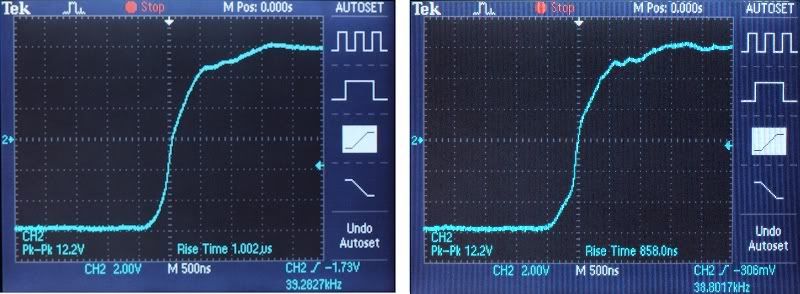
Figure 6. Cable Cooker output pulse rising edge (left) and Inductor output rising edge (right) at 0 hours of conditioning.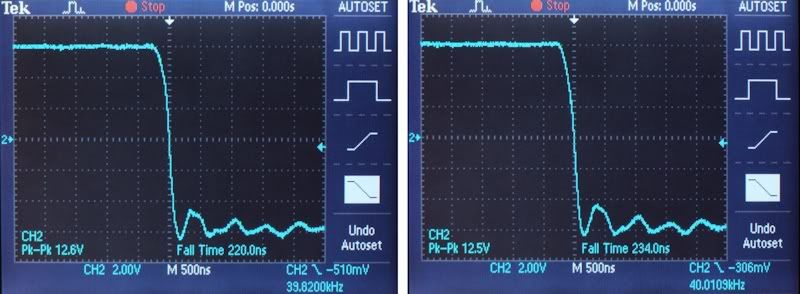
Figure 7. Cable Cooker output pulse falling edge (left) and Inductor output falling edge (right) at 0 hours of conditioning.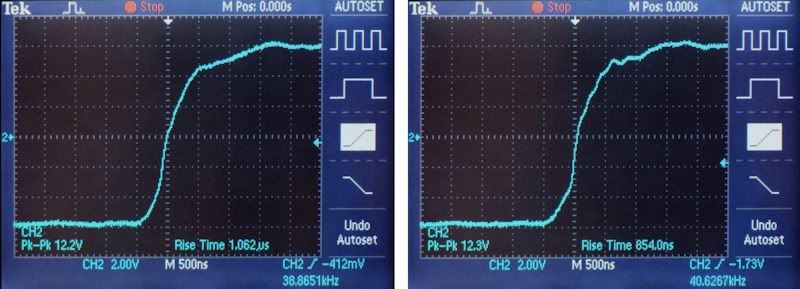
Figure 8. Cable Cooker output pulse rising edge (left) and Inductor output rising edge (right) at 55 hours of conditioning.
Figure 9. Cable Cooker output pulse falling edge (left) and Inductor output falling edge (right) at 55 hours of conditioning.
The overall output waveform distortion from the Solen inductors was minimal. With the Northcreek inductors, the greatest amount of improvement was seen after the first 24 hours. With the Solen inductors, no improvement was seen in the output waveform at the 28, 55 and 61 hour marks. This was not surprising since the output waveforms of the Cable Cooker and Solen inductors were very similar to begin with. Solen's claims of superior noise performance for these inductors was confirmed.
The inductors were reinstalled after 61 hours of conditioning. The only change noted was the sound being a little louder (measuring an average 2 dB-C higher). No further conditioning on the Cable Cooker was done. The next critical listening session was done after an additional 60 hours of music play. No audible changes were noted at that time. I speculate that, along with greatly reduced resistance (62% less than 14 gauge wire) and extensive mechanical noise abatement, the noise performance of the Solen inductors was improved by the smaller dielectric effects of the Solen inductor's red polyurethane polyamide enamel insulation on the larger wire. Ten gauge wire has 2.6 times larger cross sectional area than 14 gauge wire.
The Solen inductors reduced the direct current resistance (DCR) of the left speaker from 3.8 ohms to 3.0 ohms and reduced the DCR of the right speaker from 3.9 ohms to 3.1 ohms. Forum member Face suggested that the speakers' nominal impedance might now be in the range of 4 ohms and that I could plot the impedance response with Dayton Audio's WT3 software. The plots are shown in figures 10 and 11. The phase and impedance measurements were taken with both speakers disconnected from their amplifiers but connected to each other through the Dreadnought AI-1 non common ground interface (as they would be in normal use).
The 3dB limits of the SDA SRS 1.2TL are 27 Hz and 23 kHz. The measured impedance at 27 Hz was 3.4 ohms. It rose to 4 ohms at 35 Hz and stayed in the range of 4 ohms to 10.5 ohms from 35 Hz to 4.5 kHz. From 4.5 kHz to 11 kHz the impedance was between 3 and 4 ohms. The impedance remained above 4 ohms from 11 kHz to 20 kHz.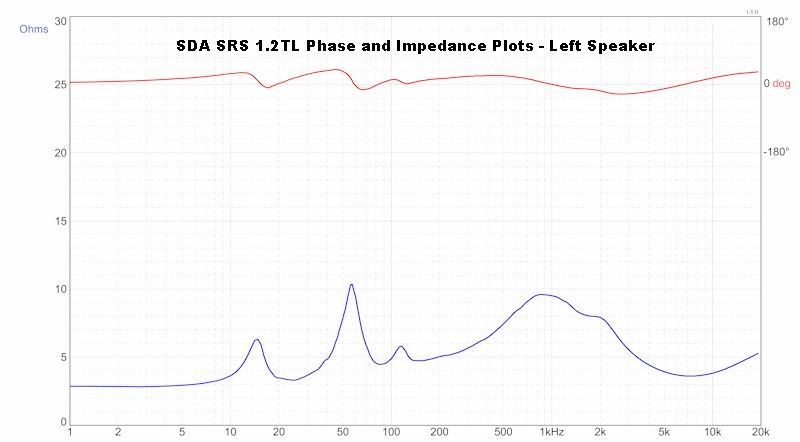
Figure 10. Phase and impedance response of the left speaker after the Solen inductor installation.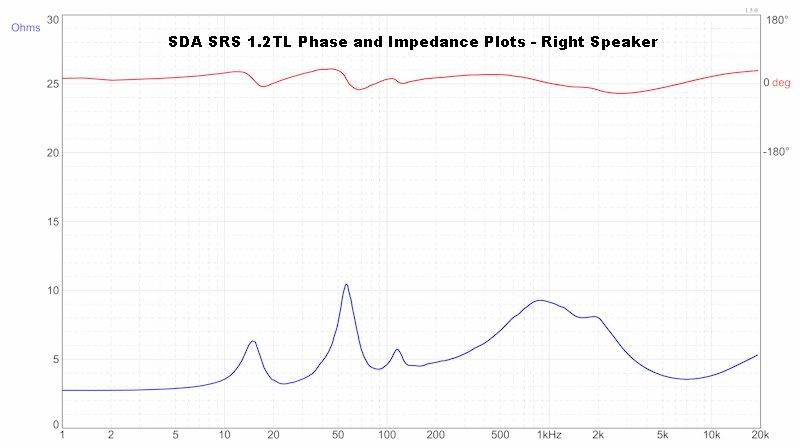
Figure 11. Phase and impedance response of the right speaker after the Solen inductor installation.
Listening Evaluation
Right out of the box, the Solen inductors enhanced the improvements brought by the Northcreek inductors. There was significant improvement in center image weight, clarity and detail. Janne reported more driver excursion with the Northcreek 16 mH SDA inductors. I did not see this when comparing one speaker with a Northcreek inductor to the other speaker with the stock inductor. I saw (and felt ) more stereo driver excursion with the Solen inductor compared to the Northcreek inductor.
) more stereo driver excursion with the Solen inductor compared to the Northcreek inductor.
The only down side to this exercise is that I now hear more variation in recording quality, particularly in the bass region.
References
Solen 10 AWG SDA Inductor Upgrade
CRS+ (1989 Version) Crossover and SDA Inductor Upgrade
SDA SRS Crossover and SDA Inductor Upgrade
Audiodharma Cable Cooker Review
AI-1 Dreadnought ProjectProud and loyal citizen of the Digital Domain and Solid State Country! -
That impedance curve is much more benign than I imagined it would be."He who fights with monsters should look to it that he himself does not become a monster. And when you gaze long into an abyss the abyss also gazes into you." Friedrich Nietzsche
-
The curves for my Northcreek-inductor-modified SDA SRS's (4 ohm nominal Z)were also surprisingly benign.
 Measurements were taken with the interconnect cable attached.
Measurements were taken with the interconnect cable attached.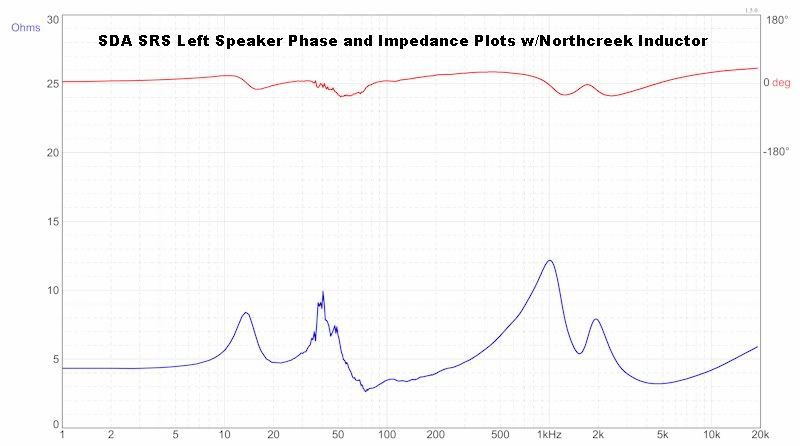
 Proud and loyal citizen of the Digital Domain and Solid State Country!
Proud and loyal citizen of the Digital Domain and Solid State Country! -
Ray,
I finished up my crossovers yesterday with the northcreek inductors,The only thing I did different is I terminated the inductors ends and plugged them straight into the crossover boards. Everything sounds fantastic as a matter of fact it only seemed to take a few hours for the inductors to shine on the lower end, even my wife noticed it right away!! the bass is is out of this world,nice tight and deep.
My plan was to use Dueland resistors but they are so long, I still might have to try them, I will just have to put some of them on the back of the board..
Have you thought of replacing the three small inductors?? I don't have the tools to do the things you do but I can say thanks for all your help.. -
TOOLFORLIFEFAN wrote: »I don't have the tools to do the things you do but I can say thanks for all your help..
I don't have the tools to do the things you do either...and thanks for all your help. TOOLFORLIFEFAN wrote: »Everything sounds fantastic as a matter of fact it only seemed to take a few hours for the inductors to shine on the lower end, even my wife noticed it right away!!
TOOLFORLIFEFAN wrote: »Everything sounds fantastic as a matter of fact it only seemed to take a few hours for the inductors to shine on the lower end, even my wife noticed it right away!!
I'll bet my next amp upgrade that your wife couldn't tell the difference between the stock crossovers and the modified crossovers in a blind test. This is all in our minds...but I like it. TOOLFORLIFEFAN wrote: »Have you thought of replacing the three small inductors?
TOOLFORLIFEFAN wrote: »Have you thought of replacing the three small inductors?
No. The only Polk recommended inductor replacement is for the SDA inductor. I do recall reading at least one forum member's report of changing the small inductors on his SDA's (I think they were 1C's) and he didn't hear a difference. I don't know of anyone who has changed the small inductors and reported an improvement, although there may be cases of this.
I'm glad your mods turned out great!Proud and loyal citizen of the Digital Domain and Solid State Country! -
I used the Erse in my 1C's and it made a big difference.Good music, a good source, and good power can make SDA's sing. Tubes make them dance.
-
IMO, I wouldn't bother as you would have a hard time finding replacements with the same DCR. Changing the DCR in those circuits would make a negative change in sound quality.TOOLFORLIFEFAN wrote: »Have you thought of replacing the three small inductors??"He who fights with monsters should look to it that he himself does not become a monster. And when you gaze long into an abyss the abyss also gazes into you." Friedrich Nietzsche -
I used the Erse in my 1C's and it made a big difference.
I am not very familiar with Erse. Where do they fall in the hierarchy of film caps? Are they considered better than Solen? How do they compare to Sonicaps?
***Edit***
While looking up info on the Erse caps, I was led to the Skiing Ninja website and was surprised to find that they offer crossover upgrade kits for a number of speaker brands, including Polk's LSi series:
Link: http://www.skiingninja.com/category-s/130.htm
After doing a search, I see that the Skiing Ninja upgrades have been discussed on the forum before, but I missed those threads when they first appeared.Proud and loyal citizen of the Digital Domain and Solid State Country! -
-
IMO, I wouldn't bother as you would have a hard time finding replacements with the same DCR. Changing the DCR in those circuits would make a negative change in sound quality.
I was wondering about the DCR,you would think it wouldn't be that hard to do but I didn't try and research it. I was still shocked when my wife mentioned the bass improvment,not only can you hear it you can feel it.
When I get my CRS+'s done I want to look into building a set of bookshelfs, something simple but something to get my feet wet..I will pick your brain then Mike.. -
DarqueKnight wrote: »I am not very familiar with Erse. Where do they fall in the hierarchy of film caps? Are they considered better than Solen? How do they compare to Sonicaps?
I found some info here: http://www.humblehomemadehifi.com/Cap.html
"Erse Pulse-X MKP 630VDC - 5% tolerance
Sound: Compared to the Transient-X from the same brand, the Pulse-X sounds rather dull and 2D. The treble is produced in a slightly "mushy" manor. This is fine when used in parallel sections and as a less critical midrange series capacitor but if you are looking for something in the tweeter's direct signal path, go for the Transient-X that is far more open, dynamic and has less background noise. Things like massed baroque choir become a mess, the Erse Pulse-X doesn't seem to keep a clear overview when the programme material gets complex. But the Transient-X is in another price-range, so not a fair comparison. The Pulse-X basically is in the same league as capacitors like the Axon True Cap, Intertechnik Audyn Cap QS, Jantzen Audio Cross Cap, SCR Chateauroux MKP-PB, Solen Fast Cap PB-MKP-FC, etc. It's a fine overall standard quality capacitor for use when your budget is very tight.
Rating: 6.5/10"
I also see that Skiing Ninja uses a combination of Erse and Sonicaps in their speaker crossover mod kits.Proud and loyal citizen of the Digital Domain and Solid State Country! -
You understand why this modification yields a bass enhancement, right? These are massive air-core inductors (used to remove the SDA effect at low frequency), and with large air-core units there is a very large DCR. Replacing the stock inductor with the monstrous Solens reduces the insertion loss in the LP filter by nearly 2 Ohms. This effectively boosts the relative woofer output. I cannot make a good guess as to the actual shape of the boost because I am not that familiar with the big SDA crossover. This might lead to a boomy presentation, especially in small rooms. Also, the minimum impedance of the speaker also drops to 3 Ohms, which is low enough to cause problems for lesser amplifiers/receivers.TOOLFORLIFEFAN wrote: »I was wondering about the DCR,you would think it wouldn't be that hard to do but I didn't try and research it. I was still shocked when my wife mentioned the bass improvment,not only can you hear it you can feel it.
When I get my CRS+'s done I want to look into building a set of bookshelfs, something simple but something to get my feet wet..I will pick your brain then Mike..
There is another alternative to this upgrade, and that is to use a steel-laminate (SL) inductor rather than air-core:
http://www.erseaudio.com/ESQ55-14-15000
You will save a significant amount of money taking this path, and the DCR will be even LOWER, so you'll almost certainly want to *add* a series resistance to flatten the FR. The bottom line is to be careful with this modification. -
"First" of all I was talking to Mike,"Second" of all I was talking to him about the three small inductors,"Third"I am using a Northcreek inductor 16mH (still air core) not a "Solen inductor"Forth" I know whats going on with the 16mH inductor from the help of Ray but I wase'nt sure how it would sound considering it's the first time I have done this.
-
You understand why this modification yields a bass enhancement, right? These are massive air-core inductors (used to remove the SDA effect at low frequency), and with large air-core units there is a very large DCR.
As I mentioned in post #57 of this thread, I actually measured lower DCR with larger air-core inductors:
Stock 16 mH, 18 AWG, SDA inductor DCR: 2.8 Ohms.
Northcreek 16 mH, 14 AWG, SDA inductor DCR: 1.3 Ohms.
Solen16 mH, 10 AWG, SDA inductor DCR: 0.8 Ohm, measured with VOM, 0.62 Ohm measured with woofer tester software (spec is 0.56 Ohm).Replacing the stock inductor with the monstrous Solens reduces the insertion loss in the LP filter by nearly 2 Ohms. This effectively boosts the relative woofer output.
"Monstrous" is such a harsh word to be used on a kinder, gentler audio forum such as ours. I hope that we can use words like "huge" or "giant" instead.

Left to right 16 mH SDA inductors: Solen 10 AWG, Northcreek 14 AWG, stock 18 AWG.I cannot make a good guess as to the actual shape of the boost because I am not that familiar with the big SDA crossover. This might lead to a boomy presentation, especially in small rooms. Also, the minimum impedance of the speaker also drops to 3 Ohms, which is low enough to cause problems for lesser amplifiers/receivers.
There is another alternative to this upgrade, and that is to use a steel-laminate (SL) inductor rather than air-core:
http://www.erseaudio.com/ESQ55-14-15000
You will save a significant amount of money taking this path, and the DCR will be even LOWER, so you'll almost certainly want to *add* a series resistance to flatten the FR. The bottom line is to be careful with this modification.
Your comments and suggestions echo those of SDA inventor and company co-founder Matthew Polk:
"...we added an inductor in each speaker between the SDA driver negative terminal and the amp negative terminal on that side. At low frequencies that diverts the signal back to ground instead of through the interconnect to the SDA drivers in the other speaker. As a result, at very low frequencies the Right SDA drivers produce only right channel bass and vice versa, while still producing the R-L and L-R signals at higher frequencies. The transition occurs between about 50Hz and 150Hz.
However, because of the DC resistance of the inductor, the system isn't perfect. I don't recall the DC resistance of these coils but it was high, at least several ohms depending on the model. This means that the SDA drivers will continue to produce some SDA signal even at very low frequencies. Decreasing the DC resistance will definitely improve the bass response of the system both qualitatively and quantitatively. However, before you rush out to buy those Hi-Q replacement inductors be aware of some concerns.
We chose the higher DC air core coils for a couple of good reasons. First, we were always on the edge of acceptability with the impedance of the SDA's. The DCR of these coils kept the minimum impedance high enough for the amps available in those days. Depending on the model, reducing the DC resistance of these coils may take the minimum impedance down to around 2
ohms. If your amp doesn't mind, you shouldn't either.
The other concern is saturation of the inductor core. Air core inductors don't saturate. Given the cost of adequate ferrite or laminated core inductors at the time, plus the need for a higher DCR, the air core choice was obvious. So, when switching to a ferrite or laminated core inductor make sure it will handle at least 5 amps without saturation. That's equivalent to 100 watts of low frequency power through the SDA driver." -- Matthew Polk
Matthew Polk's complete comments on this matter, as well as some additional comments by Stu Lumsden, Polk's VP of Engineering, are provided in a PDF attachment at the bottom of post #2 in this thread.
Based on Mr. Polk's recommendation, the specs of the ERSE would probably work fine in most applications:
ESQ55-14-15000 steel laminate inductor specs:
Inductance: 15.0mH
Wire Gauge: 14ga
Coil Type: ESQ - Super Q Coil.
DCR: 0.337Ω
Power Rating: 600wProud and loyal citizen of the Digital Domain and Solid State Country! -
DarqueKnight wrote: »I am not very familiar with Erse. Where do they fall in the hierarchy of film caps? Are they considered better than Solen? How do they compare to Sonicaps?
***Edit***
While looking up info on the Erse caps, I was led to the Skiing Ninja website and was surprised to find that they offer crossover upgrade kits for a number of speaker brands, including Polk's LSi series:
Link: http://www.skiingninja.com/category-s/130.htm
After doing a search, I see that the Skiing Ninja upgrades have been discussed on the forum before, but I missed those threads when they first appeared.
Erse isn't caps, or at least if they make them I didn't use them. I replaced the large inductors with an Erse:
http://www.parts-express.com/pe/showdetl.cfm?Partnumber=266-954%20%20%20%20%20%20%20%20&FTR=266-954Good music, a good source, and good power can make SDA's sing. Tubes make them dance. -
Sorry, I was replying to an earlier post.DarqueKnight wrote: »...Based on Mr. Polk's recommendation, the specs of the ERSE would probably work fine in most applications:
ESQ55-14-15000 steel laminate inductor specs:
Inductance: 15.0mH
Wire Gauge: 14ga
Coil Type: ESQ - Super Q Coil.
DCR: 0.337Ω
Power Rating: 600w
Yes, that's the one I used.
As for the other components of my upgrade, I used Soniccaps, Mills, and Cardas posts. Didn't do Ben's TL upgrade, though, my 1C's are using 194's.Good music, a good source, and good power can make SDA's sing. Tubes make them dance. -
And I only did the big inductor on each speaker, didn't touch the smaller ones on the boards.Good music, a good source, and good power can make SDA's sing. Tubes make them dance.
-
Right. Just to be clear the only worry with iron core inductors is saturation, but these Erse units are rated at 600W so saturation is not going to happen unless you are driving them very, very hard. Of course you can always put more than one inductor in series to increase the saturation limit.DarqueKnight wrote: »Based on Mr. Polk's recommendation, the specs of the ERSE would probably work fine in most applications:
ESQ55-14-15000 steel laminate inductor specs:
Inductance: 15.0mH
Wire Gauge: 14ga
Coil Type: ESQ - Super Q Coil.
DCR: 0.337Ω
Power Rating: 600w
I know you're aware of this issue, but ensuring that the magnetic fluxes are minimally linked is critical too, which might happen in order to save space. The best way to do this is imagine a beam of light passing through the inductor core, and always ensure these beams neither cross nor remain parallel. -
Agreed, except that I found the stock inductor to be "giant"!DarqueKnight wrote: »"Monstrous" is such a harsh word to be used on a kinder, gentler audio forum such as ours. I hope that we can use words like "huge" or "giant" instead.
-
I used the Erse for my SDA's. Works great and is very inexpensive. Iron cores are not bad when used at such a low frequency.Please. Please contact me a ben62670 @ yahoo.com. Make sure to include who you are, and you are from Polk so I don't delete your email. Also I am now physically unable to work on any projects. If you need help let these guys know. There are many people who will help if you let them know where you are.
Thanks
Ben -
I generally use the SL inductors rather than air core whenever the component value is greater than roughly 1mH. In my mind, the main issue when designing a speaker is to keep the insertion loss as low as possible so that the efficiency is as high as possible. On the other hand, with the big SDA, you needed the inductor DCR to save you from the very low (roughly 2 Ohm) impedance caused by paralleling the two groups of 4 series/parallel woofers. Those were probably some tough design decisions at the time.I used the Erse for my SDA's. Works great and is very inexpensive. Iron cores are not bad when used at such a low frequency. -
There are actually two inductors in the same circuit paralleled. You just don't see it so easily. What you end up with is half the inductance and half the DCR. With very low DCR like I have it makes the dimensional easier to overdrive, but you need it so loud you can't really listen to it that way.Please. Please contact me a ben62670 @ yahoo.com. Make sure to include who you are, and you are from Polk so I don't delete your email. Also I am now physically unable to work on any projects. If you need help let these guys know. There are many people who will help if you let them know where you are.
Thanks
Ben -
After about 20 minutes of thinking about it, I see that is exactly correct! The two inductors are perfectly in parallel. Very neat.There are actually two inductors in the same circuit paralleled. You just don't see it so easily. What you end up with is half the inductance and half the DCR. With very low DCR like I have it makes the dimensional easier to overdrive, but you need it so loud you can't really listen to it that way. -
That is why I use a single inductor of only 8mh and very low DCR. The coil is in the middle of the SDA connector tied to the amps grounds. It was a lot cheaper than getting 2 16mh inductors and mounting them in the cabinet. Only draw back is that I can not use the A-1 transformer for non common ground amps.Please. Please contact me a ben62670 @ yahoo.com. Make sure to include who you are, and you are from Polk so I don't delete your email. Also I am now physically unable to work on any projects. If you need help let these guys know. There are many people who will help if you let them know where you are.
Thanks
Ben -
That's seems like a neat solution. Honestly that way you could more conveniently play with inductor (and series resistor) component values to optimize the woofer response.That is why I use a single inductor of only 8mh and very low DCR. The coil is in the middle of the SDA connector tied to the amps grounds. It was a lot cheaper than getting 2 16mh inductors and mounting them in the cabinet. -
With very low DCR like I have it makes the dimensional easier to overdrive, but you need it so loud you can't really listen to it that way.
By lowering the DCR of the SDA inductor from 2.8 to .8 ohms, you are adding significantly more drive to the SDA array and attenuating some of the opposite channel SDA signal below 50 - 150 Htz.
Is it accurate to say the SDA array is now being driven harder with stereo signal than is the stereo array below 150 - 50 Htz?
How does this effect the low/mid bass tonal balance and total bass output. It is a very positive change or is it unbalanced or excessive?
I'm thinking of performing this mod to my 1.2's using the Erse inductors. I'm driving them with a Carver TFM 35 that's rated at 750W/C at 2 Ohm, 150 damping factor.
TFM-35 SPECIFICATIONS
Frequency Repsonse: 20-20kHz +0,-0.2dB
Power Output: FTC 20hz-20khz
8ohm 250 watts per channel
4ohm 400 watts per channel
2ohm 750 watts per channel
Bridged mono power output: 800 watts into 8 ohms
THD: less than 0.08%
Dynamic Headroom: >1.0dB @ 8ohms both channels driven
Gain: 29.0 dB (+/- 0.5dB)
Input Impedance 47 kohms
Damping Factor: >150 typical (20hz-20 khz)'65 427 Shelby Cobra
'72 Triumph TR-6
__________________
'88 Polk SDA SRS 1.2, with upgraded XO caps and Erse SDA inductors
'86 Polk SDA CRS+
'84 Polk Monitor 10A (Peerless tweeters)
'05 HSU VTF-3 Sub (Original OEM)
'20 HSU VTF-3 Sub (three more, 100% cloned)
'93 Carver TFM-35
'88 Carver M-1.0t
'88 Adcom GFT-555
'88 Adcom GFP-555
'88 Adcom GFA-555 (upgraded/restored)
'88 Adcom GFA-555 (a second one upgraded/restored)
'05 Onkyo DV-555 media
'89 Fosgate 360 Digital Space Matrix
'89 Fosgate 360 Digital Space Matrix, internal surround amp bridged to drive only a center channel
'91 Kenwood Basic M1D Amp
'89 Pioneer Laser Disc media
'89 Sony SuperBeta HiFi media
One PGA2310 based custom built remote volume control
Four Polk T-15's
Four Polk TSi-200's
Four Polk TSi-100's
Two Polk CS-10's -
The only thing it affects is the bass slam. Doesn't hurt the SDA affect at all. You should be fine with that amp. You would need to replace both inductors because of the B/B IC in the older series.Please. Please contact me a ben62670 @ yahoo.com. Make sure to include who you are, and you are from Polk so I don't delete your email. Also I am now physically unable to work on any projects. If you need help let these guys know. There are many people who will help if you let them know where you are.
Thanks
Ben






